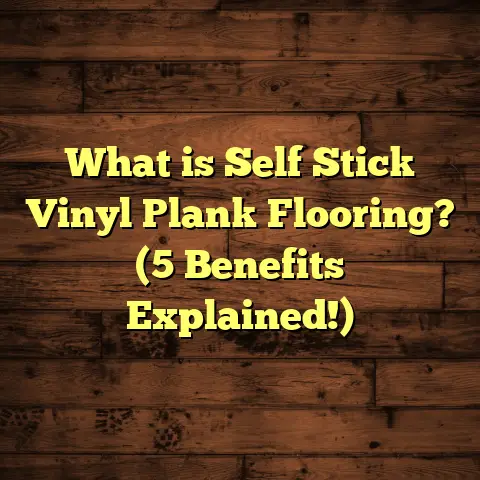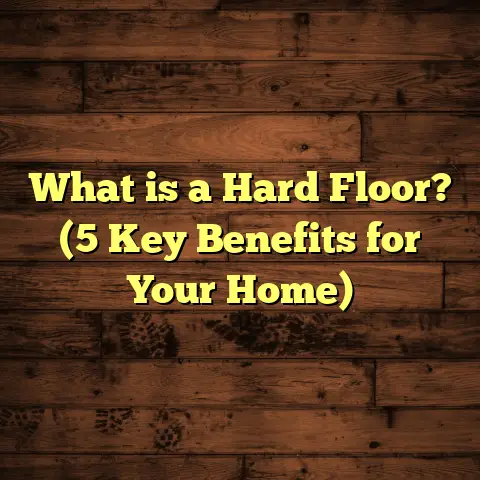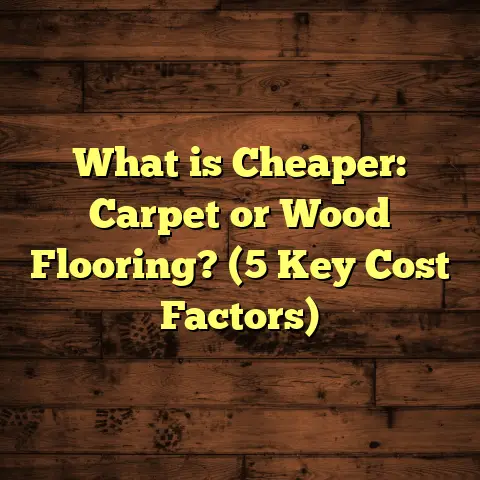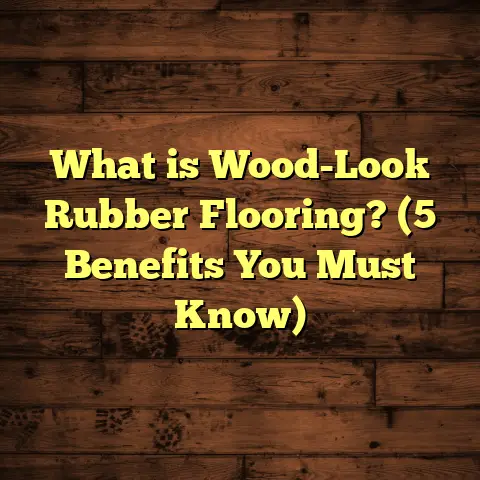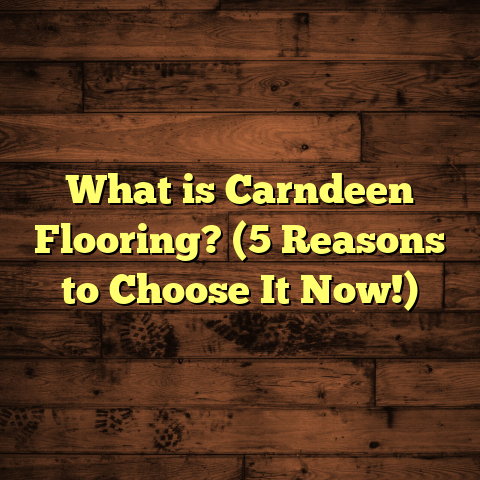What is Resilient Plank Flooring? (7 Benefits for Your Home)
When I first encountered resilient plank flooring, it was during a job where a client needed something durable, affordable, and stylish—something that could take a beating from two young kids and an energetic dog. I wasn’t sure if it would hold up, but after months of monitoring that project and many others, I’ve come to appreciate just how versatile and practical this flooring option is. Let me walk you through what resilient plank flooring really is, why it might be a great fit for your home, and some things I’ve learned from real-life projects.
What is Resilient Plank Flooring?
Resilient plank flooring is a broad term often used to describe flooring products made from synthetic materials designed to look like hardwood or stone but built to be tougher and more flexible. The main types include luxury vinyl plank (LVP) and luxury vinyl tile (LVT), both popular for residential and commercial use.
At its core, resilient plank flooring features several layers fused together:
- Wear Layer: This is a transparent topcoat that protects against scratches, stains, and wear. It’s usually measured in mils—thicker layers mean better durability.
- Design Layer: Beneath the wear layer lies a printed design that’s often so realistic you’d swear it’s wood or stone.
- Core Layer: Made from PVC or a wood-plastic composite, this gives the plank its thickness and stability.
- Backing Layer: The bottom layer stabilizes the plank and sometimes adds sound insulation.
The magic comes from the combination of these layers. The planks are flexible enough to absorb impacts without cracking but sturdy enough to hold their shape over time. The result is a floor that looks beautiful, handles spills and traffic well, and feels comfortable underfoot.
In my experience, this balance is exactly why homeowners choose resilient plank flooring over traditional hardwood or ceramic tile. It’s like having the best of both worlds: good looks with practical performance.
Understanding the Materials
You might wonder what makes resilient plank flooring so resilient. Vinyl is the main component here. Vinyl itself has been around for decades as a flooring material because it offers water resistance, durability, and ease of maintenance.
What sets modern resilient planks apart is how manufacturers have engineered them with advanced wear layers and improved cores. Some planks use WPC (wood-plastic composite) or SPC (stone-plastic composite) cores. These cores add rigidity or waterproof features depending on their makeup.
For example:
- WPC cores tend to be thicker and offer more cushioning underfoot.
- SPC cores are denser and harder, providing greater impact resistance.
Choosing the right core depends on your needs—if you want softer floors in bedrooms or living rooms, WPC might be better. For kitchens or basements where moisture is a concern, SPC is often preferred.
What I’ve Seen Work Well – Success Stories
One of my favorite projects involved installing resilient plank flooring in a bustling family home with kids aged 3 and 5 plus a dog that loved muddy walks. The family had tried hardwood before but struggled with scratches and water damage near the kitchen sink.
When we switched to luxury vinyl plank with a 15 mil wear layer, everything changed. The floors looked stunning, almost like real wood, but they responded well to daily abuse. Muddy paw prints wiped off with ease. Spills didn’t soak in. Toys dropped on the floor didn’t leave marks.
I checked back after a year, and the family was thrilled. They saved thousands by avoiding expensive repairs or refinishing jobs. Plus, their cleaning routine became simpler—just sweeping and damp mopping instead of special wood treatments.
Another success story came from an elderly couple who wanted safer floors to reduce slipping hazards. The soft cushion of resilient planks gave them better grip and comfort when walking or standing for long periods. They appreciated the quiet too; it absorbed footsteps better than their old hardwood.
Challenges I’ve Encountered
Like every flooring type, resilient plank flooring isn’t perfect. Knowing the challenges helps set realistic expectations.
Subfloor Preparation Is Critical
One pitfall I’ve seen repeatedly is improper subfloor prep. Resilient flooring requires a flat, clean surface before installation. If there are bumps or dips, the planks won’t lay properly, leading to gaps or uneven wear down the line.
I once had a job where the subfloor was wooden but had not been sanded or leveled correctly. After installation, customers noticed creaking noises and some planks shifting slightly underfoot. We had to lift sections and redo parts of the floor—a costly lesson.
Indentations from Heavy Furniture
While resilient planks resist scratches well, heavy furniture legs can leave dents over time if no protective pads are used. One client placed a large steel-framed bookcase directly on their floor without pads; after several months, dents appeared beneath.
I always recommend using felt pads or rubber coasters under heavy items to prevent this kind of damage.
UV Fading Can Occur
Sunlight exposure can gradually fade colors on lower-quality resilient plank floors. A client with large south-facing windows noticed their floor colors muted within two years in certain spots.
Choosing planks with UV-resistant coatings helps reduce this problem, especially in sunlit rooms.
Repairing Damage Isn’t Always Simple
Unlike solid hardwood where you can sand and refinish damaged sections, resilient plank repairs usually mean replacing planks entirely. This isn’t always difficult since many planks are designed for easy removal, but it requires keeping extra material on hand.
Why Choose Resilient Plank Flooring? Here Are 7 Benefits That Matter
I want to share what I consider the biggest advantages of resilient plank flooring based on my work with clients over the years. Maybe these will help you decide if it fits your lifestyle:
1. Outstanding Water Resistance
This feature alone makes resilient plank flooring a favorite for kitchens, bathrooms, laundry rooms, and basements.
Water pools sit on top instead of seeping into the material like wood would. This means no warping or swelling after spills or minor flooding events.
In fact, in one project I managed in a basement prone to slight dampness during heavy rains, the resilient floor stayed intact for over five years without any sign of damage—a testament to its resilience against moisture.
2. Speedy Installation Saves You Time
Compared to tile or hardwood that require adhesives or nails, most resilient planks use click-lock systems that snap together easily.
This means less downtime during renovations and lower labor costs if you’re hiring pros—or even DIY installation if you’re confident.
On average, I can install 300-400 square feet per day with my team for click-lock resilient planks versus 150-200 square feet for traditional hardwood.
3. Long-Lasting Durability for Active Spaces
The wear layer thickness varies by product but generally ranges from 8 mils (residential grade) up to 20 mils (commercial grade).
Many of my clients with pets or kids choose 12 mil or thicker options because they stand up better to scratches from claws and dropped objects.
Statistically speaking, quality resilient plank floors last 10-20 years before needing replacement when properly maintained—a lifespan comparable to hardwood in many cases.
4. Comfortable Feel Underfoot
Walking on tile or stone can feel cold and hard; hardwood is warmer but still firm.
Resilient plank flooring often includes an attached underlayment that softens each step and reduces noise transfer between floors—great for families with children running around or upstairs neighbors wanting peace.
One client told me how much easier it was on her knees during long cooking sessions compared to tile she previously had installed.
5. Huge Range of Styles for Every Taste
I’m always impressed by how realistic high-end luxury vinyl planks look nowadays. Thanks to advances in printing technology and embossing techniques, textures mimic natural grains so well that even trained eyes struggle to tell them apart from real wood.
From rustic oak to sleek maple, distressed barnwood to exotic teak—there’s something for every décor style at various price points.
For those who want stone looks without cold hardness or grout maintenance, resilient tile versions replicate marble or slate beautifully.
6. Low Maintenance Means Less Hassle
This is a benefit I personally enjoy—a quick sweep and mop routine keeps floors looking fresh without special cleaners or refinishing.
For busy households juggling work, kids’ activities, or pets, this simplicity translates into real time saved weekly.
I heard from one client who used to dread cleaning her hardwood floors but now enjoys how easy it is to keep her resilient plank floors spotless after dinner parties or game nights.
7. Healthier Indoor Environment
Many products now meet strict certifications like FloorScore® which limits volatile organic compounds (VOCs) emissions post-installation.
This helps maintain better indoor air quality—a big plus for families with allergies or respiratory issues.
In fact, some healthcare facilities prefer resilient vinyl floors because they combine hygiene benefits with comfort and durability.
The Cost Factor: What Should You Expect?
Budgeting is one area where I see confusion often arise. Prices vary widely depending on brand quality, core type (WPC vs SPC), wear layer thickness, design complexity, and installation complexity.
Here’s a ballpark breakdown based on recent projects:
| Item | Cost per Sq Ft (USD) |
|---|---|
| Material (basic grade) | $2.00 – $3.50 |
| Material (high-end grade) | $4.50 – $7.00 |
| Professional installation | $1.50 – $4.00 |
| Total Installed Cost | $3.50 – $11.00 |
For example, installing 1,000 sq ft of mid-range resilient plank flooring might cost between $4,500 – $8,000 fully installed depending on region and labor rates.
To avoid surprises during budgeting phases in my projects, I use FloorTally — an online tool that helps me quickly calculate local material costs plus labor rates while factoring waste percentages due to cutting errors or leftover scraps.
FloorTally also allows me to compare different material options side-by-side which makes client consultations easier and more transparent about where money goes.
A Closer Look: Case Studies From My Projects
I’d like to share some detailed case studies showing how resilient plank flooring worked out in different scenarios:
Case Study #1: Family-Friendly Kitchen & Living Room Reno
A family with three kids wanted new flooring after their hardwood suffered scratches and water stains from spills over five years.
We chose an SPC core luxury vinyl plank with a 15 mil wear layer featuring textured oak grain visuals.
Installation took two days including proper subfloor leveling and moisture barrier application since it was over concrete slab foundation.
Feedback after one year:
- No visible scratches despite heavy foot traffic.
- Easy cleanup after spills.
- Comfortable feel during meal prep.
- No signs of wear near pet feeding area.
- Budget came in 10% under estimate thanks to precise waste calculation using FloorTally data.
Case Study #2: Basement Recreation Space
The homeowners wanted a warm look without moisture worries in their basement game room which occasionally experienced dampness during storms.
We installed WPC core resilient planks with attached underlayment for softness plus waterproof membrane underneath.
After three years:
- Floors remained flat without swelling.
- Sound absorption improved game room acoustics.
- Kids enjoyed walking barefoot comfortably.
- No mold or mildew issues detected.
- Customers expressed satisfaction with overall value vs previous carpet option which held odors.
Case Study #3: Senior Living Safety & Comfort Upgrade
An elderly couple needed floor replacement prioritizing slip resistance and comfort over aesthetics initially.
We selected a low-profile resilient plank with textured surface for grip and WPC core for cushioning effects.
After six months:
- Reduced slips reported by clients.
- Easier mobility due to forgiving surface.
- Positive feedback on warmth compared to tile they previously had.
- Minimal cleaning effort appreciated by caretakers.
My Tips for Choosing Resilient Plank Flooring That Lasts
If you’re thinking about using this type of flooring at home, here are some things I’ve learned that make all the difference:
- Pick the right wear layer thickness: For homes with pets or kids, aim for at least 12 mil wear layer.
- Consider the core material: SPC cores are best for moisture-prone areas; WPC offers better softness.
- Invest in UV-resistant options: Especially if your room gets direct sunlight.
- Prepare your subfloor properly: Leveling is non-negotiable—take time here to avoid future headaches.
- Protect your floors: Use furniture pads under heavy pieces to prevent dents.
- Keep extra planks handy: For future repairs—you’ll thank yourself later.
- Check VOC certifications: To keep indoor air healthier.
Final Thoughts From My Flooring Journey
Resilient plank flooring has proven itself many times over as an excellent choice balancing looks, durability, comfort, and cost-efficiency. Like any product though, it’s not flawless and requires smart choices about materials and installation practices.
I believe it’s ideal for families juggling active lifestyles who want floors that look good without demanding constant care or worry about water damage.
If you’re curious how resilient plank flooring would perform in your space—or want help planning your next project—I’m happy to chat more anytime!
Got any questions about specific brands or installation tips? Just ask—I’ve got plenty more stories and advice up my sleeve!
